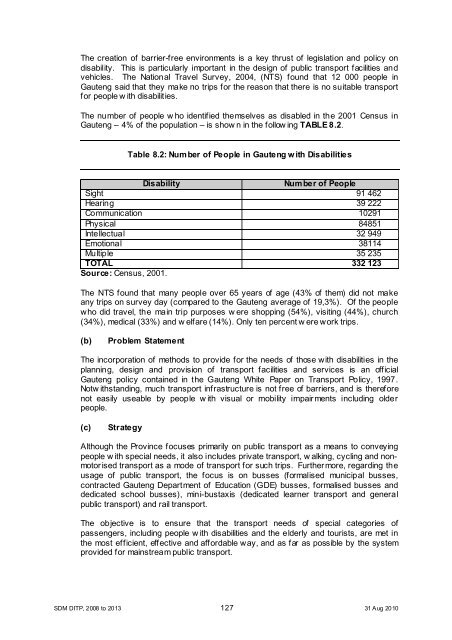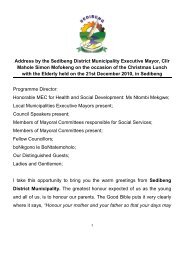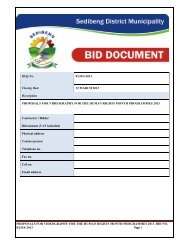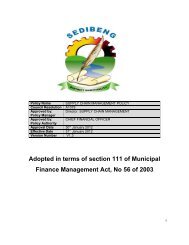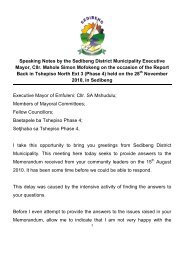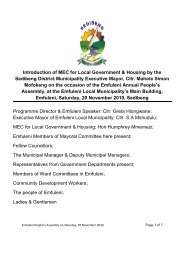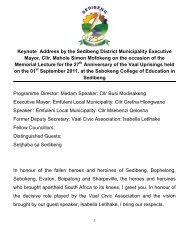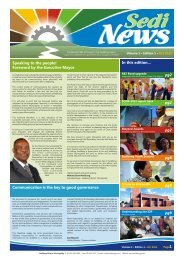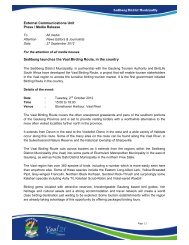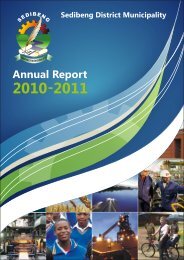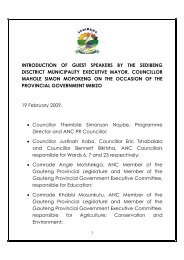Chapter 11 - Sedibeng District Municipality
Chapter 11 - Sedibeng District Municipality
Chapter 11 - Sedibeng District Municipality
Create successful ePaper yourself
Turn your PDF publications into a flip-book with our unique Google optimized e-Paper software.
The creation of barrier-free environments is a key thrust of legislation and policy on<br />
disability. This is particularly important in the design of public transport facilities and<br />
vehicles. The National Travel Survey, 2004, (NTS) found that 12 000 people in<br />
Gauteng said that they make no trips for the reason that there is no suitable transport<br />
for people w ith disabilities.<br />
The number of people w ho identified themselves as disabled in the 2001 Census in<br />
Gauteng – 4% of the population – is show n in the follow ing TABLE 8.2.<br />
Table 8.2: Number of People in Gauteng w ith Disabilities<br />
Disability<br />
Number of People<br />
Sight 91 462<br />
Hearing 39 222<br />
Communication 10291<br />
Physical 84851<br />
Intellectual 32 949<br />
Emotional 38<strong>11</strong>4<br />
Multiple 35 235<br />
TOTAL 332 123<br />
Source: Census, 2001.<br />
The NTS found that many people over 65 years of age (43% of them) did not make<br />
any trips on survey day (compared to the Gauteng average of 19,3%). Of the people<br />
who did travel, the main trip purposes w ere shopping (54%), visiting (44%), church<br />
(34%), medical (33%) and w elfare (14%). Only ten percent w ere work trips.<br />
(b)<br />
Problem Statement<br />
The incorporation of methods to provide for the needs of those with disabilities in the<br />
planning, design and provision of transport facilities and services is an official<br />
Gauteng policy contained in the Gauteng White Paper on Transport Policy, 1997.<br />
Notw ithstanding, much transport infrastructure is not free of barriers, and is therefore<br />
not easily useable by people w ith visual or mobility impairments including older<br />
people.<br />
(c)<br />
Strategy<br />
Although the Province focuses primarily on public transport as a means to conveying<br />
people w ith special needs, it also includes private transport, w alking, cycling and nonmotorised<br />
transport as a mode of transport for such trips. Furthermore, regarding the<br />
usage of public transport, the focus is on busses (formalised municipal busses,<br />
contracted Gauteng Department of Education (GDE) busses, formalised busses and<br />
dedicated school busses), mini-bustaxis (dedicated learner transport and general<br />
public transport) and rail transport.<br />
The objective is to ensure that the transport needs of special categories of<br />
passengers, including people w ith disabilities and the elderly and tourists, are met in<br />
the most efficient, effective and affordable way, and as far as possible by the system<br />
provided for mainstream public transport.<br />
SDM DITP, 2008 to 2013 127 31 Aug 2010


